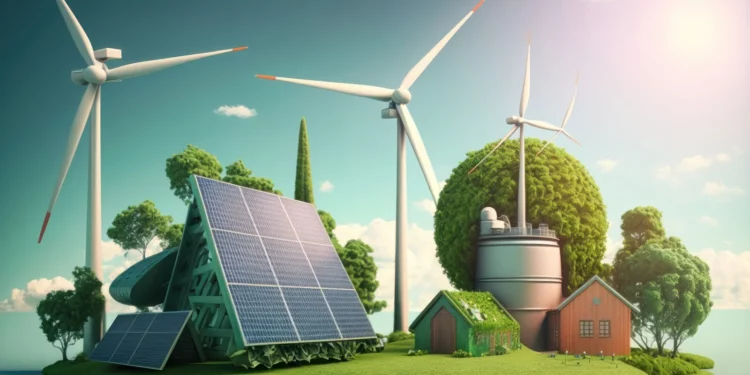In recent years, the world has witnessed a significant shift towards renewable energy sources, driven by a growing awareness of the environmental impacts of traditional fossil fuels and the urgent need to combat climate change. From solar and wind to hydro and geothermal power, renewable energy technologies have experienced remarkable advancements, paving the way for a more sustainable and greener future.
Solar Power: Harnessing the Power of the Sun
Solar power stands at the forefront of renewable energy advancements, with innovations continuously pushing the boundaries of efficiency and affordability. The development of photovoltaic (PV) cells has revolutionized the way we capture and convert sunlight into electricity. Breakthroughs in materials science and manufacturing techniques have led to the production of more durable, lightweight, and cost-effective solar panels.
Moreover, research into next-generation solar technologies, such as perovskite solar cells and concentrated solar power (CSP) systems, holds promise for even greater efficiency and scalability. With ongoing investments in solar energy infrastructure and the declining costs of installation, solar power is becoming increasingly accessible to households, businesses, and communities worldwide.
Wind Energy: Turbines of Tomorrow
Wind energy has emerged as a key player in the renewable energy landscape, with advancements in turbine design and technology driving significant growth in capacity and output. The development of larger, more efficient wind turbines, coupled with improvements in aerodynamics and materials, has led to higher energy yields and lower operational costs.
Furthermore, innovations such as offshore wind farms and vertical-axis turbines are expanding the potential for harnessing wind power in diverse environments, including coastal regions and urban areas. With ongoing research focused on enhancing reliability, grid integration, and energy storage solutions, wind energy is poised to play a vital role in meeting the world’s growing energy demands.
Hydroelectric Power: Tapping into Hydropower Potential
Hydroelectric power has long been a reliable source of renewable energy, utilizing the kinetic energy of flowing water to generate electricity. Recent advancements in hydroelectric technology, including the development of low-impact run-of-river systems and pumped storage facilities, are making hydropower more sustainable and environmentally friendly.
Moreover, innovations in turbine design and fish-friendly infrastructure are addressing concerns about the impact of dams and reservoirs on aquatic ecosystems. With a focus on optimizing efficiency and minimizing environmental footprint, hydroelectric power remains a valuable asset in the transition to a cleaner energy future.
Geothermal Energy: Tapping into Earth’s Heat
Geothermal energy offers a reliable and constant source of renewable power by harnessing the Earth’s natural heat from beneath the surface. Advancements in drilling techniques and reservoir management have unlocked new geothermal resources, enabling the development of enhanced geothermal systems (EGS) and geothermal heat pumps for both electricity generation and heating applications.
Furthermore, innovations in geothermal power plant design, such as binary cycle technology and modular units, are improving efficiency and scalability while reducing costs. With abundant geothermal potential waiting to be tapped, ongoing research and investment in geothermal energy hold the promise of sustainable and baseload power generation.
Bioenergy: Harvesting Organic Matter
Bioenergy encompasses a diverse range of renewable fuels derived from organic materials, including biomass, biogas, and biofuels. Advances in biomass conversion technologies, such as anaerobic digestion and thermochemical processes, are enabling the efficient conversion of agricultural residues, forestry waste, and organic byproducts into bioenergy.
Moreover, research into advanced biofuels, such as cellulosic ethanol and algae-based biofuels, holds the potential to reduce greenhouse gas emissions and dependence on fossil fuels in the transportation sector. By harnessing the power of nature’s carbon cycle, bioenergy offers a sustainable pathway towards energy independence and environmental stewardship.
The Future of Renewable Energy: Opportunities and Challenges
As renewable energy continues to evolve and expand, it presents unprecedented opportunities for economic growth, job creation, and environmental sustainability. However, realizing the full potential of renewable energy requires addressing various challenges, including intermittency, grid integration, policy support, and investment in research and development.
Moreover, ensuring equitable access to clean energy resources and mitigating environmental and social impacts are essential considerations in the transition to a renewable energy future. By fostering collaboration between governments, industries, and communities, we can overcome these challenges and accelerate the global transition towards a more sustainable and resilient energy system.
Conclusion: Driving the Transition Towards a Sustainable Future
In conclusion, renewable energy advancements are reshaping the global energy landscape, offering solutions to mitigate climate change, enhance energy security, and promote economic development. From solar and wind to hydro and geothermal power, the evolution of renewable technologies holds immense promise for a cleaner, greener, and more prosperous future. By embracing innovation, investing in infrastructure, and fostering international cooperation, we can harness the power of renewable energy to build a more sustainable world for generations to come.
































































